Dingwen Zhang
Pursuing Temporal-Consistent Video Virtual Try-On via Dynamic Pose Interaction
May 22, 2025Abstract:Video virtual try-on aims to seamlessly dress a subject in a video with a specific garment. The primary challenge involves preserving the visual authenticity of the garment while dynamically adapting to the pose and physique of the subject. While existing methods have predominantly focused on image-based virtual try-on, extending these techniques directly to videos often results in temporal inconsistencies. Most current video virtual try-on approaches alleviate this challenge by incorporating temporal modules, yet still overlook the critical spatiotemporal pose interactions between human and garment. Effective pose interactions in videos should not only consider spatial alignment between human and garment poses in each frame but also account for the temporal dynamics of human poses throughout the entire video. With such motivation, we propose a new framework, namely Dynamic Pose Interaction Diffusion Models (DPIDM), to leverage diffusion models to delve into dynamic pose interactions for video virtual try-on. Technically, DPIDM introduces a skeleton-based pose adapter to integrate synchronized human and garment poses into the denoising network. A hierarchical attention module is then exquisitely designed to model intra-frame human-garment pose interactions and long-term human pose dynamics across frames through pose-aware spatial and temporal attention mechanisms. Moreover, DPIDM capitalizes on a temporal regularized attention loss between consecutive frames to enhance temporal consistency. Extensive experiments conducted on VITON-HD, VVT and ViViD datasets demonstrate the superiority of our DPIDM against the baseline methods. Notably, DPIDM achieves VFID score of 0.506 on VVT dataset, leading to 60.5% improvement over the state-of-the-art GPD-VVTO approach.
Semantic-Aligned Learning with Collaborative Refinement for Unsupervised VI-ReID
Apr 27, 2025Abstract:Unsupervised visible-infrared person re-identification (USL-VI-ReID) seeks to match pedestrian images of the same individual across different modalities without human annotations for model learning. Previous methods unify pseudo-labels of cross-modality images through label association algorithms and then design contrastive learning framework for global feature learning. However, these methods overlook the cross-modality variations in feature representation and pseudo-label distributions brought by fine-grained patterns. This insight results in insufficient modality-shared learning when only global features are optimized. To address this issue, we propose a Semantic-Aligned Learning with Collaborative Refinement (SALCR) framework, which builds up optimization objective for specific fine-grained patterns emphasized by each modality, thereby achieving complementary alignment between the label distributions of different modalities. Specifically, we first introduce a Dual Association with Global Learning (DAGI) module to unify the pseudo-labels of cross-modality instances in a bi-directional manner. Afterward, a Fine-Grained Semantic-Aligned Learning (FGSAL) module is carried out to explore part-level semantic-aligned patterns emphasized by each modality from cross-modality instances. Optimization objective is then formulated based on the semantic-aligned features and their corresponding label space. To alleviate the side-effects arising from noisy pseudo-labels, we propose a Global-Part Collaborative Refinement (GPCR) module to mine reliable positive sample sets for the global and part features dynamically and optimize the inter-instance relationships. Extensive experiments demonstrate the effectiveness of the proposed method, which achieves superior performances to state-of-the-art methods. Our code is available at \href{https://github.com/FranklinLingfeng/code-for-SALCR}.
CityGS-X: A Scalable Architecture for Efficient and Geometrically Accurate Large-Scale Scene Reconstruction
Mar 29, 2025Abstract:Despite its significant achievements in large-scale scene reconstruction, 3D Gaussian Splatting still faces substantial challenges, including slow processing, high computational costs, and limited geometric accuracy. These core issues arise from its inherently unstructured design and the absence of efficient parallelization. To overcome these challenges simultaneously, we introduce CityGS-X, a scalable architecture built on a novel parallelized hybrid hierarchical 3D representation (PH^2-3D). As an early attempt, CityGS-X abandons the cumbersome merge-and-partition process and instead adopts a newly-designed batch-level multi-task rendering process. This architecture enables efficient multi-GPU rendering through dynamic Level-of-Detail voxel allocations, significantly improving scalability and performance. Through extensive experiments, CityGS-X consistently outperforms existing methods in terms of faster training times, larger rendering capacities, and more accurate geometric details in large-scale scenes. Notably, CityGS-X can train and render a scene with 5,000+ images in just 5 hours using only 4 * 4090 GPUs, a task that would make other alternative methods encounter Out-Of-Memory (OOM) issues and fail completely. This implies that CityGS-X is far beyond the capacity of other existing methods.
Navigating Semantic Drift in Task-Agnostic Class-Incremental Learning
Feb 11, 2025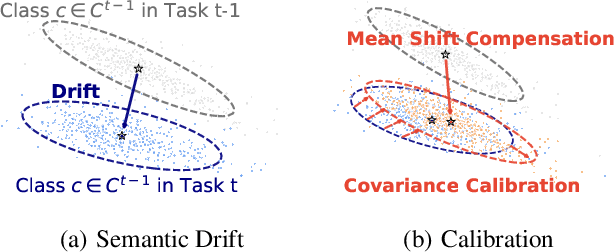
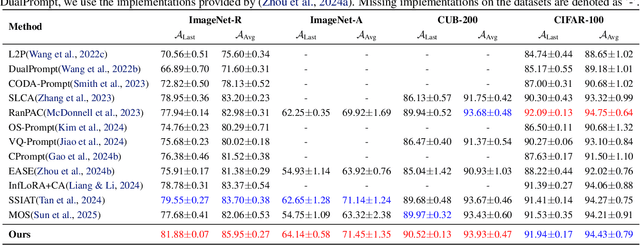
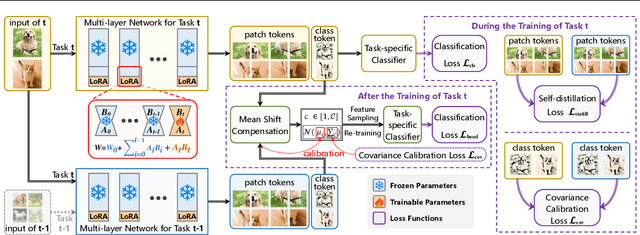
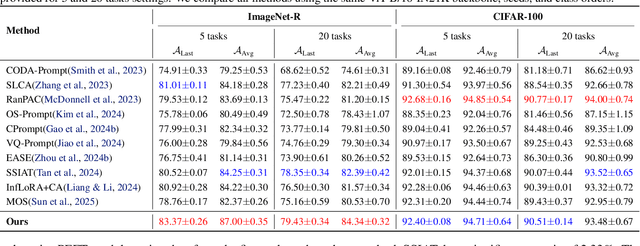
Abstract:Class-incremental learning (CIL) seeks to enable a model to sequentially learn new classes while retaining knowledge of previously learned ones. Balancing flexibility and stability remains a significant challenge, particularly when the task ID is unknown. To address this, our study reveals that the gap in feature distribution between novel and existing tasks is primarily driven by differences in mean and covariance moments. Building on this insight, we propose a novel semantic drift calibration method that incorporates mean shift compensation and covariance calibration. Specifically, we calculate each class's mean by averaging its sample embeddings and estimate task shifts using weighted embedding changes based on their proximity to the previous mean, effectively capturing mean shifts for all learned classes with each new task. We also apply Mahalanobis distance constraint for covariance calibration, aligning class-specific embedding covariances between old and current networks to mitigate the covariance shift. Additionally, we integrate a feature-level self-distillation approach to enhance generalization. Comprehensive experiments on commonly used datasets demonstrate the effectiveness of our approach. The source code is available at \href{https://github.com/fwu11/MACIL.git}{https://github.com/fwu11/MACIL.git}.
HV-BEV: Decoupling Horizontal and Vertical Feature Sampling for Multi-View 3D Object Detection
Dec 25, 2024



Abstract:The application of vision-based multi-view environmental perception system has been increasingly recognized in autonomous driving technology, especially the BEV-based models. Current state-of-the-art solutions primarily encode image features from each camera view into the BEV space through explicit or implicit depth prediction. However, these methods often focus on improving the accuracy of projecting 2D features into corresponding depth regions, while overlooking the highly structured information of real-world objects and the varying height distributions of objects across different scenes. In this work, we propose HV-BEV, a novel approach that decouples feature sampling in the BEV grid queries paradigm into horizontal feature aggregation and vertical adaptive height-aware reference point sampling, aiming to improve both the aggregation of objects' complete information and generalization to diverse road environments. Specifically, we construct a learnable graph structure in the horizontal plane aligned with the ground for 3D reference points, reinforcing the association of the same instance across different BEV grids, especially when the instance spans multiple image views around the vehicle. Additionally, instead of relying on uniform sampling within a fixed height range, we introduce a height-aware module that incorporates historical information, enabling the reference points to adaptively focus on the varying heights at which objects appear in different scenes. Extensive experiments validate the effectiveness of our proposed method, demonstrating its superior performance over the baseline across the nuScenes dataset. Moreover, our best-performing model achieves a remarkable 50.5% mAP and 59.8% NDS on the nuScenes testing set.
CoSurfGS:Collaborative 3D Surface Gaussian Splatting with Distributed Learning for Large Scene Reconstruction
Dec 23, 2024Abstract:3D Gaussian Splatting (3DGS) has demonstrated impressive performance in scene reconstruction. However, most existing GS-based surface reconstruction methods focus on 3D objects or limited scenes. Directly applying these methods to large-scale scene reconstruction will pose challenges such as high memory costs, excessive time consumption, and lack of geometric detail, which makes it difficult to implement in practical applications. To address these issues, we propose a multi-agent collaborative fast 3DGS surface reconstruction framework based on distributed learning for large-scale surface reconstruction. Specifically, we develop local model compression (LMC) and model aggregation schemes (MAS) to achieve high-quality surface representation of large scenes while reducing GPU memory consumption. Extensive experiments on Urban3d, MegaNeRF, and BlendedMVS demonstrate that our proposed method can achieve fast and scalable high-fidelity surface reconstruction and photorealistic rendering. Our project page is available at \url{https://gyy456.github.io/CoSurfGS}.
Seamless Detection: Unifying Salient Object Detection and Camouflaged Object Detection
Dec 22, 2024Abstract:Achieving joint learning of Salient Object Detection (SOD) and Camouflaged Object Detection (COD) is extremely challenging due to their distinct object characteristics, i.e., saliency and camouflage. The only preliminary research treats them as two contradictory tasks, training models on large-scale labeled data alternately for each task and assessing them independently. However, such task-specific mechanisms fail to meet real-world demands for addressing unknown tasks effectively. To address this issue, in this paper, we pioneer a task-agnostic framework to unify SOD and COD. To this end, inspired by the agreeable nature of binary segmentation for SOD and COD, we propose a Contrastive Distillation Paradigm (CDP) to distil the foreground from the background, facilitating the identification of salient and camouflaged objects amidst their surroundings. To probe into the contribution of our CDP, we design a simple yet effective contextual decoder involving the interval-layer and global context, which achieves an inference speed of 67 fps. Besides the supervised setting, our CDP can be seamlessly integrated into unsupervised settings, eliminating the reliance on extensive human annotations. Experiments on public SOD and COD datasets demonstrate the superiority of our proposed framework in both supervised and unsupervised settings, compared with existing state-of-the-art approaches. Code is available on https://github.com/liuyi1989/Seamless-Detection.
PolSAM: Polarimetric Scattering Mechanism Informed Segment Anything Model
Dec 17, 2024Abstract:PolSAR data presents unique challenges due to its rich and complex characteristics. Existing data representations, such as complex-valued data, polarimetric features, and amplitude images, are widely used. However, these formats often face issues related to usability, interpretability, and data integrity. Most feature extraction networks for PolSAR are small, limiting their ability to capture features effectively. To address these issues, We propose the Polarimetric Scattering Mechanism-Informed SAM (PolSAM), an enhanced Segment Anything Model (SAM) that integrates domain-specific scattering characteristics and a novel prompt generation strategy. PolSAM introduces Microwave Vision Data (MVD), a lightweight and interpretable data representation derived from polarimetric decomposition and semantic correlations. We propose two key components: the Feature-Level Fusion Prompt (FFP), which fuses visual tokens from pseudo-colored SAR images and MVD to address modality incompatibility in the frozen SAM encoder, and the Semantic-Level Fusion Prompt (SFP), which refines sparse and dense segmentation prompts using semantic information. Experimental results on the PhySAR-Seg datasets demonstrate that PolSAM significantly outperforms existing SAM-based and multimodal fusion models, improving segmentation accuracy, reducing data storage, and accelerating inference time. The source code and datasets will be made publicly available at \url{https://github.com/XAI4SAR/PolSAM}.
DGTR: Distributed Gaussian Turbo-Reconstruction for Sparse-View Vast Scenes
Nov 20, 2024
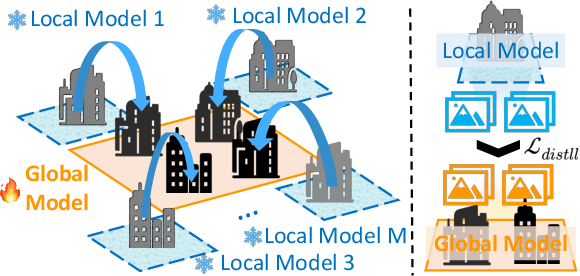


Abstract:Novel-view synthesis (NVS) approaches play a critical role in vast scene reconstruction. However, these methods rely heavily on dense image inputs and prolonged training times, making them unsuitable where computational resources are limited. Additionally, few-shot methods often struggle with poor reconstruction quality in vast environments. This paper presents DGTR, a novel distributed framework for efficient Gaussian reconstruction for sparse-view vast scenes. Our approach divides the scene into regions, processed independently by drones with sparse image inputs. Using a feed-forward Gaussian model, we predict high-quality Gaussian primitives, followed by a global alignment algorithm to ensure geometric consistency. Synthetic views and depth priors are incorporated to further enhance training, while a distillation-based model aggregation mechanism enables efficient reconstruction. Our method achieves high-quality large-scale scene reconstruction and novel-view synthesis in significantly reduced training times, outperforming existing approaches in both speed and scalability. We demonstrate the effectiveness of our framework on vast aerial scenes, achieving high-quality results within minutes. Code will released on our [https://3d-aigc.github.io/DGTR].
Mamba Capsule Routing Towards Part-Whole Relational Camouflaged Object Detection
Oct 05, 2024Abstract:The part-whole relational property endowed by Capsule Networks (CapsNets) has been known successful for camouflaged object detection due to its segmentation integrity. However, the previous Expectation Maximization (EM) capsule routing algorithm with heavy computation and large parameters obstructs this trend. The primary attribution behind lies in the pixel-level capsule routing. Alternatively, in this paper, we propose a novel mamba capsule routing at the type level. Specifically, we first extract the implicit latent state in mamba as capsule vectors, which abstract type-level capsules from pixel-level versions. These type-level mamba capsules are fed into the EM routing algorithm to get the high-layer mamba capsules, which greatly reduce the computation and parameters caused by the pixel-level capsule routing for part-whole relationships exploration. On top of that, to retrieve the pixel-level capsule features for further camouflaged prediction, we achieve this on the basis of the low-layer pixel-level capsules with the guidance of the correlations from adjacent-layer type-level mamba capsules. Extensive experiments on three widely used COD benchmark datasets demonstrate that our method significantly outperforms state-of-the-arts. Code has been available on https://github.com/Liangbo-Cheng/mamba\_capsule.
 Add to Chrome
Add to Chrome Add to Firefox
Add to Firefox Add to Edge
Add to Edge